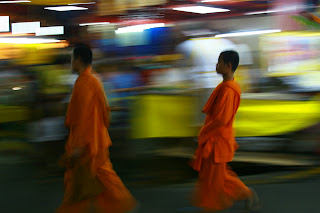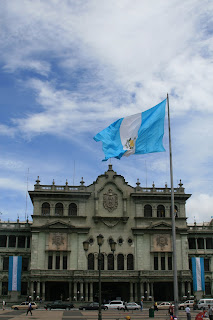 The recruits march in lines of five, to the snap of snare drums and singing songs of war, trailing long shadows in the early morning sun.
The recruits march in lines of five, to the snap of snare drums and singing songs of war, trailing long shadows in the early morning sun.Training camp graduation is still a week away for these new recruits of the Shan State Army, one of Burma’s last armed resistance groups, but their drill sergeants are looking for a perfect performance during the festivities of the Shan New Year, on the first new moon of December.
The soldiers are a disheveled crew, once farmers and monks, wearing worn out boots and dusty uniforms and carrying Vietnam War-era M-16s and Chinese AK-47s. Their bodies are a canvas of traditional tattoos; snarling tigers, dragons, crossed spears and ancient Pali scriptures they claim will deflect bullets and ward off hunger and cold. Their faces are vacant, their footsteps hollow.
They march to the parade grounds, past the bamboo and thatch houses of Loi Tai Leng, the mountaintop headquarters of the Shan State Army, on the border with Thailand. They will practice their routines repeatedly for the rest of the day in preparation for Shan New Year.
The celebration of the New Year for the Shan, Burma’s largest ethnic minority, is the biggest event of the year in Loi Tai Leng, an otherwise quiet fortified village of 2-3,000. It is now year 2102 for the Shan, and year 46 of the SSA’s armed struggle against the Burmese military government. But as the calendar quietly turns in this forgotten corner of Burma, the future of this rebel army and their people isn’t looking any brighter.
Each year the Burmese consolidate their control by building supply roads that snake around the SSA’s shrinking pockets of territory and carry troops and artillery to jungle outposts. The SSA soldiers, who live off of broken rice and soybean cakes and have been paid only $12 this year, resort to guerilla tactics to ambush Burmese battalions on patrol.
“They are many and we are few,” says one veteran soldier. “We shoot them and run. We kill them and run.”
Despite admitting his army is outnumbered by at least 40 to 1, Colonel Yawd Serk, the bespectacled leader of the SSA, remains confident.
“It depends on your heart, not only your gun,” he said. “It depends on your morale, your spirit. Hitler had many soldiers, but he lost.”
At the end of his speech on New Year’s Day, Col. Serk silences a crowd still snickering from the missteps of the recruits by pulling a pistol from his belt and firing it into the air. On cue, a volley of missiles and mortars whizz off in plumes of white smoke from the forest below, sending thunder across the valleys on impact.
Col. Serk later boasts about the theatrics with a challenge to the Burmese military. “We showed the enemy today,” he said. “If they turn on their T.V.s, they will see the pictures. If they want to come fight, we welcome them. If this year they don’t come, then next year we will go to them!”
But sitting in the crowd are a group of civilians from Burmese-controlled areas of Shan State who walked for weeks through landmine-littered jungles under the cover of darkness to see the festivities. They live a much different reality than the military bluster of Loi Tai Leng.
These civilians have recent, firsthand accounts of Burmese troops terrorizing their villages for information on the SSA, stealing livestock, burning down houses and raping women.
Among them is Khun Thaw, 43, who three months ago escaped four years of forced labor for a Burmese military battalion. The beatings rendered him nearly deaf, and one of his ribs is still broken. He lived on the banana tree trunks the Burmese troops fed him – an edible st
 alk often given to pigs. He said the Burmese troops would use the porters as human shields during firefights with rebels, shooting over their shoulders for safety.
alk often given to pigs. He said the Burmese troops would use the porters as human shields during firefights with rebels, shooting over their shoulders for safety.His wife and four children have had no word of him since the Burmese soldiers took him captive, and it’s too dangerous for him to go back and find them.
“I have no family anymore, no clothes. I am hurting,” he said.
Hsai Aung Nyat, 26, is another civilian who arrived at Loi Tai Leng two weeks ago. He said a Burmese battalion came to his village last month and “arrested, beat and tortured” the headman on suspicion of being an informer for the SSA. He said it’s a common occurrence in many villages.
“I don’t know if he’s alive or dead,” Nyat said. “No one wants to replace him. It’s too dangerous.”
The civilians said their situation has worsened after the military crushed September’s democracy protests in central Burma, but that the repression has been decades-long in the remote areas of eastern Burma where foreigners are not allowed to travel and there are no cell phones or internet bloggers to document it.
In a purely pragmatic sense, the SSA can rely on the abuses of the Burmese military as a failsafe recruitment strategy. Many of its 10,000 soldiers are fighting with a painfully personal chip on their shoulder.
Sai Shwe, 18, is one of the recruits who graduated on New Year’s Day. He still has the full cheeks of a child, and his voice shakes when he tells his story. Shwe had left his home in central Shan State to become a novice monk when he learned of a Burmese attack on his village. He returned to find his aunt raped by Burmese soldiers.
“I wanted revenge,” he said, blinking hard. “I think only one thing now that I’ve graduated. I want to go back inside and take revenge for my aunt.”
It’s a sentiment echoed by Sai Yawd Merng, 32, a monk for twenty years and now a second lieutenant in the SSA.
“Here, if you have no gun it’s like you’re sticking your neck out for them to cut it,” he said. “Civilians have become the victims of war. Now, without a gun, you will not see peace in Burma.”
Col. Serk concedes that the dedication to pacifism of Burma’s democracy icon, Aung San Suu Kyi, is a brave strategy, but finds little relevance in it for the Shan. While enjoying international fame, Suu Kyi’s support isn’t universal in her country’s tribal peripheries, largely because she is ethnically Burmese – the 60 percent majority of the country which has historically lorded over the minorities.
“It’s a different situation in a different country,” Col. Serk said. “She is working for the Burmese, not for the Shan.”
And so, after the debris of the Shan New Year’s celebration is cleared away, and the village headquarters of Loi Tai Leng returns to business as usual, the next year looks to be more of the same for Burma’s largest minority and the rebel army fighting for its freedom.
In these haunting mountain ranges, stacked slate blue against the sun, the sounds of celebration fade fast.

















 The Thai/Myanmar Friendship Bridge, from Mae Sot to Myawaddy, built with Thai money in 1996. Some Burmese pay 30 baht ($1) to cross it to find work in Thailand. Others take a boat to go around it for free.
The Thai/Myanmar Friendship Bridge, from Mae Sot to Myawaddy, built with Thai money in 1996. Some Burmese pay 30 baht ($1) to cross it to find work in Thailand. Others take a boat to go around it for free. Shaliman is a Burmese girl of Muslim, Indian origin. She likes to play with her friends under the bridge, beside the older boys and girls hawking bottles of smuggled whiskey and cartons of cigarettes.
Shaliman is a Burmese girl of Muslim, Indian origin. She likes to play with her friends under the bridge, beside the older boys and girls hawking bottles of smuggled whiskey and cartons of cigarettes. We jumped off the pickup truck an hour outside of Mae Sot, after the police checkpoint and in front of the gates of Mae La Refugee Camp.
We jumped off the pickup truck an hour outside of Mae Sot, after the police checkpoint and in front of the gates of Mae La Refugee Camp.





 Pon is from Laos. She came to Bangkok two years ago because she could earn more money here. She likes to joke. She exaggerates figures when she speaks, then hastily backtracks when called out. Hers is not the most remarkable of lives. But it’s a life. One of Bangkok’s 10 million. And, as far as lives go, it’s a consistent one. You can find her on the same street corner in Bangkok’s grimy automotive repair district every morning of the week except Sunday, when she rests. She’s there at six and she’s gone by two.
Pon is from Laos. She came to Bangkok two years ago because she could earn more money here. She likes to joke. She exaggerates figures when she speaks, then hastily backtracks when called out. Hers is not the most remarkable of lives. But it’s a life. One of Bangkok’s 10 million. And, as far as lives go, it’s a consistent one. You can find her on the same street corner in Bangkok’s grimy automotive repair district every morning of the week except Sunday, when she rests. She’s there at six and she’s gone by two. She’s in her twenties, has two children and a boyfriend. She comes from the countryside of southern Laos, where she planted rice with her family. She came to Bangkok looking for opportunity. She misses her family and country, but is able to go back to visit five times every year.
She’s in her twenties, has two children and a boyfriend. She comes from the countryside of southern Laos, where she planted rice with her family. She came to Bangkok looking for opportunity. She misses her family and country, but is able to go back to visit five times every year. Some days she only makes 300 baht, about US$10. Those numbers went up and down as we talked. Whatever the case, it’s not a lot, and she sends much of it back to her mother in Laos, who is looking after her son.
Some days she only makes 300 baht, about US$10. Those numbers went up and down as we talked. Whatever the case, it’s not a lot, and she sends much of it back to her mother in Laos, who is looking after her son.






